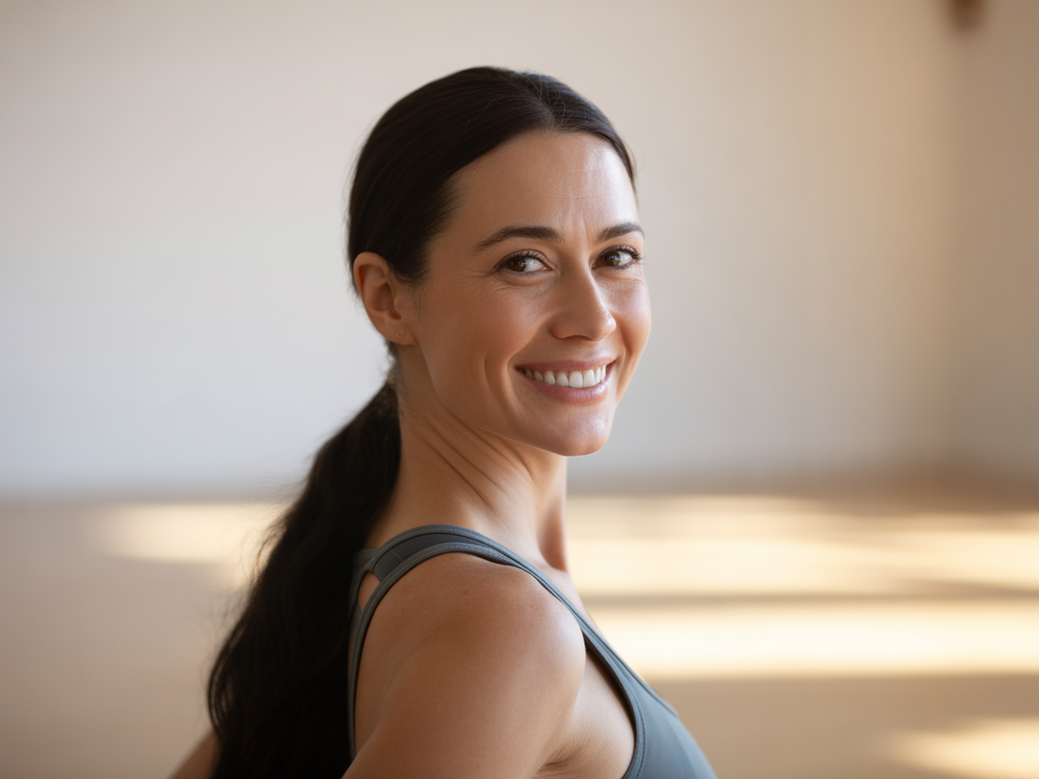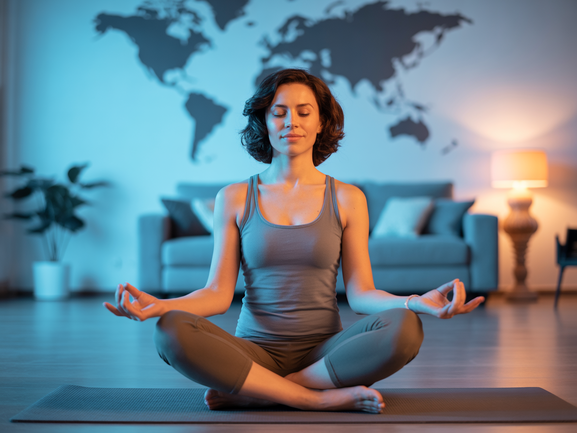Yoga for Stress Relief: A Guide to Finding Your Calm
What is Yoga for Stress Relief?
In our fast-paced world, finding a moment of peace can feel like a distant dream. Yoga for stress relief is a powerful practice designed to bridge that gap. It combines physical postures (asanas), controlled breathing (pranayama), and mindfulness meditation to soothe the nervous system and counteract the body’s stress responses. This holistic approach helps lower cortisol, the primary stress hormone, guiding you toward a state of profound relaxation and inner balance.
This isn’t about contorting into complex poses. Instead, the focus of using yoga for stress is to build a mindful connection between your body and mind. My name is Luzia, an international yoga teacher and co-founder of the Vitalizen App | Yoga + Meditation. My mission is to democratize well-being by sharing the transformative power of yoga. To understand our vision, it’s helpful to know what Vitalizen.app is and the passion that drives us.
Why Is Proactive Stress Management Crucial in 2025?

The demands of modern life have reached a fever pitch, making effective stress management more critical than ever. Chronic stress is a silent epidemic linked to severe health issues, including anxiety, depression, heart disease, and a compromised immune system. It impacts not only your physical health but also your mental clarity, productivity, and overall quality of life.
According to a 2025 report from the Global Wellness Institute, 76% of adults report that stress negatively impacts their daily lives, a 15% increase from just five years ago.
Adopting proactive strategies is no longer a luxury—it’s a fundamental part of a healthy, sustainable lifestyle. By integrating a consistent stress management yoga routine, you build resilience, enabling you to navigate life’s challenges with greater calm and purpose.
The Science Behind Using Yoga to Reduce Stress
The profound benefits of yoga for stress management are not just anecdotal; they are firmly supported by scientific research. The practice directly influences your body’s physiological stress responses. When you engage in yoga, you activate the parasympathetic nervous system—the “rest and digest” system—which counteracts the “fight or flight” response triggered by stress.
Here are the key scientific benefits of a regular yoga practice:
- Cortisol Reduction: Consistent yoga practice is proven to lower levels of cortisol. Lowering this primary stress hormone helps mitigate its negative long-term effects on the body.
- GABA Increase: Groundbreaking studies from the Boston University School of Medicine show that yoga can significantly increase levels of gamma-aminobutyric acid (GABA), a neurotransmitter that reduces nerve activity and promotes calmness.
- Improved Heart Rate Variability (HRV): A higher HRV indicates a more adaptable and resilient nervous system. Research from the National Center for Complementary and Integrative Health (NCCIH) confirms that yoga is an effective tool for improving HRV.
During my years teaching in the USA, Canada, France, and Italy, I witnessed this universal need firsthand. Stress is a global challenge, which ignited the vision for a platform that could transcend geographical boundaries. This led me to co-found Vitalizen, making these scientifically-proven benefits of yoga for stress relief accessible to everyone, everywhere.
What Are the Best Yoga Practices for Stress Relief?
While nearly any style of yoga can help alleviate stress, certain practices are exceptionally effective at calming the mind and releasing physical tension. The most beneficial yoga practices for stress emphasize slow, mindful movements and deep, conscious breathing. It’s about discovering what feels most restorative for *your* body.
Top 3 Yoga Styles for Beating Stress:
- Hatha Yoga: A foundational, slower-paced style perfect for beginners. Hatha focuses on holding basic poses to build strength, improve alignment, and cultivate body awareness.
- Yin Yoga: This meditative practice involves holding passive floor poses for several minutes. It targets the body’s deep connective tissues, releasing stored tension and fostering a state of deep introspection.
- Restorative Yoga: The ultimate practice for relaxation. Restorative yoga uses props like bolsters, blocks, and blankets to completely support the body, allowing for deep rest and nervous system rejuvenation.
These styles are central to the guided sessions available on Vitalizen, offering a clear path to begin your journey.
🎯 Ready to start? Explore our guided programs and find the perfect yoga for stress relief session for you.
Creating Your At-Home Sanctuary for Stress Relief
To truly benefit from an online yoga for stress relief practice, creating a dedicated space is key. It doesn’t need to be large or elaborate; it just needs to be a corner of your home that signals to your brain it’s time to unwind and focus inward. A calm environment enhances the stress-reducing effects of your practice.

Steps to Set Up Your Space:
- Choose a Quiet Spot: Find a low-traffic area where you’re least likely to be disturbed.
- Declutter: A clean, organized space helps create a clear, focused mind. Keep only your essential yoga props here.
- Add Calming Elements: Incorporate items that soothe your senses, like a small plant, a candle with a relaxing scent (like lavender), or soft, dimmable lighting.
- Keep Props Accessible: Have your mat, a blanket, and any other props (like blocks or a bolster) ready to go. This removes any friction to starting your practice.
This personal sanctuary becomes a powerful tool, making your commitment to daily stress management through yoga feel effortless and inviting.
A 15-Minute Yoga Sequence to Melt Away Stress
Consistency is more important than duration. Even a short, 15-minute session can reset your entire day. This simple sequence is designed to release tension from the neck, shoulders, and hips—areas where stress commonly accumulates. It’s a perfect example of effective yoga to reduce stress.
- Child’s Pose (Balasana) – 2 minutes: Kneel on your mat, sit back on your heels, and fold forward, resting your forehead on the floor. This pose gently stretches the back and calms the mind.
- Cat-Cow Stretch (Marjaryasana-Bitilasana) – 3 minutes: Move to all fours. Inhale as you drop your belly and look up (Cow), and exhale as you round your spine and tuck your chin (Cat). Sync your breath with the movement to warm up the spine.
- Downward-Facing Dog (Adho Mukha Svanasana) – 2 minutes: From all fours, lift your hips up and back. Gently pedal your feet to stretch your hamstrings. This inversion helps calm the nervous system.
- Low Lunge (Anjaneyasana) – 3 minutes (1.5 mins per side): Step one foot forward between your hands. Keep your back knee on the ground. This pose releases tension in the hips.
- Legs-Up-The-Wall Pose (Viparita Karani) – 5 minutes: Lie on your back with your legs extending up a wall. This is a deeply restorative pose that promotes circulation and tranquility.
Online Yoga vs. In-Person Classes: Which is Better for You?
Choosing between an online platform and a traditional studio depends entirely on your lifestyle, budget, and personal preferences. While in-person classes offer community, online yoga provides unmatched flexibility—a crucial factor when you’re already trying to manage a stressful schedule.
Online Yoga (Vitalizen)
- Unmatched Convenience: Practice anytime, anywhere, eliminating travel time and stress.
- Affordability: Subscription models offer unlimited access for less than the cost of a few studio classes.
- Endless Variety: Access a vast library of styles, levels, and session lengths 24/7.
- Personalized Pace: Pause, rewind, and practice at a pace that feels right for you.
In-Person Classes
- Community Connection: Practice alongside others in a shared, energetic space.
- Hands-On Adjustments: Instructors can provide physical corrections to your alignment.
- Fixed Schedule: A set class time can provide structure and accountability.
- Dedicated Environment: A studio is a space designed specifically for distraction-free practice.
Frequently Asked Questions
Who is Luzia and what makes her an expert?
Luzia is an accomplished international yoga teacher and the co-founder of the Vitalizen app. With extensive experience teaching in the USA, Canada, France, and Italy, she brings a wealth of knowledge and a global perspective on wellness. Her passion lies in making yoga and meditation accessible to everyone as powerful, science-backed tools for stress relief and personal growth.
How can the Vitalizen app specifically help with my stress?
Vitalizen offers a holistic approach to stress management. The app provides a variety of guided yoga sessions, mindfulness meditations, and breathing techniques specifically designed to calm the nervous system. By offering structured programs and the flexibility to practice anytime, Vitalizen empowers you to build a consistent wellness routine that fits your lifestyle, leading to a more balanced life.
How much time do I need to practice yoga to see benefits?
Consistency is more important than duration. Even 10-15 minutes of daily practice can make a significant difference in your stress levels. The Vitalizen app offers sessions ranging from 5-minute meditations to full 60-minute classes, so you can always find something that fits your schedule. A little bit of yoga for stress relief every day is more effective than one long session per week.
Do I need to be flexible to start yoga?
Absolutely not! This is one of the most common myths. Yoga is not about touching your toes; it’s about what you learn on the way down. The practice will help you improve your flexibility and strength over time. Vitalizen offers beginner-friendly programs designed to introduce you to the fundamentals of yoga for stress in a safe and supportive way.
Are You Ready to Find Your Calm?
Luzia’s journey from a traveling yoga teacher to the co-founder of a digital wellness platform is a testament to the power of turning passion into positive impact. If you’re ready to take the first step towards a less stressful, more mindful life, we invite you to explore the articles, news, and guidance on yoga and meditation on our blog.
💡 Tip: Download our free guide to deepen your knowledge and enhance your stress management yoga practice!
For any questions or to share your own journey, feel free to contact us. We are here to support you every step of the way.

